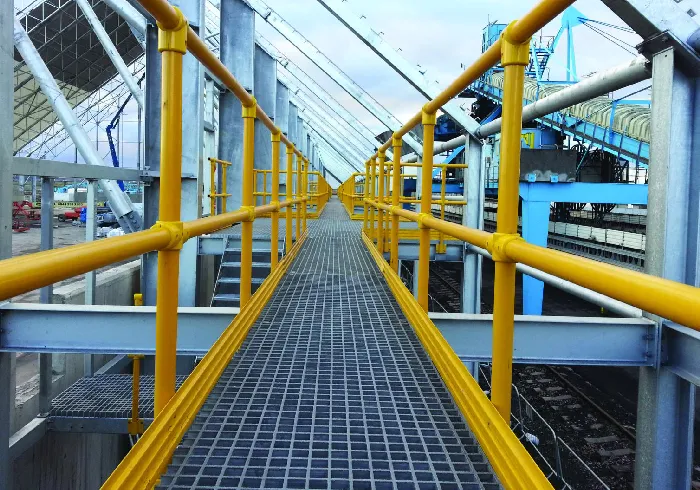loading...
- No. 9, Xingyuan South Street, Dongwaihuan Road, Zaoqiang County, Hengshui, Hebei, China
- admin@zjcomposites.com
- +86 15097380338
- Welcome to visit our website!
Enhanced Durability of Protruded Grating Using FRP for Optimal Performance and Safety
Understanding FRP Protruded Grating Features, Benefits, and Applications
Fiber Reinforced Plastic (FRP) protruded grating is an advanced composite material that has gained significant attention in various industries due to its robustness, lightweight nature, and superior corrosion resistance. This article aims to explore the fundamental aspects of FRP protruded grating, including its features, benefits, and practical applications, thereby highlighting its importance in modern construction and industrial settings.
What is FRP Protruded Grating?
FRP protruded grating is manufactured from a combination of fiberglass reinforcement and a thermosetting resin. The process involves pultrusion, where the fiberglass is drawn through a heated die, creating a solid, continuous product with a defined profile. The result is a grating system characterized by its exceptional strength-to-weight ratio. The grating typically features a surface with raised or protruded sections that enhance slip resistance, making it an ideal choice for industrial walkways, platforms, and other pedestrian areas.
Key Features of FRP Protruded Grating
1. Corrosion Resistance One of the primary advantages of FRP protruded grating is its exceptional resistance to corrosion. Unlike traditional materials like steel or aluminum, FRP does not rust or deteriorate when exposed to harsh chemicals, water, or UV radiation. This attribute makes it particularly suitable for environments like sewage treatment plants, chemical processing facilities, and coastal areas.
2. Lightweight FRP grating is significantly lighter than metal alternatives, making it easier to handle and install. The reduced weight can also lead to lower transportation costs and the potential for smaller support structures, which can save on overall material costs.
3. Durability FRP grating is engineered to withstand heavy loads and impacts. Its structural integrity remains intact under adverse conditions, providing longevity and reliability even in demanding applications.
4. Slip Resistance The design of protruded grating includes a textured surface that offers superior slip resistance, enhancing safety for personnel working in potentially hazardous environments, such as wet or oily floors.
5. Thermal Insulation FRP materials do not conduct electricity, providing excellent insulation against electrical hazards. This is particularly crucial in environments where electrical safety is a concern.
6. Aesthetic Flexibility Available in a range of colors and finishes, FRP protruded grating can be tailored to match specific aesthetic requirements, making it suitable for architectural applications as well.
Benefits of Using FRP Protruded Grating
frp protruded grating

The benefits of incorporating FRP protruded grating into projects extend across various sectors
- Cost-Effectiveness While the initial cost of FRP may be higher than traditional materials, the long-term savings associated with reduced maintenance and replacement costs can make it a more economical choice over time. - Environmental Impact The production of FRP materials can be more environmentally friendly than that of metal or wood, and their longevity means less frequent replacement, reducing waste.
- Ease of Installation Lighter weight and pre-fabricated sections allow for faster installation, meaning projects can be completed more efficiently, translating to time savings and reduced labor costs.
Applications of FRP Protruded Grating
FRP protruded grating serves a wide array of applications across various industries, including
1. Chemical Processing Facilities With excellent chemical resistance, FRP grating is ideal for walkways, platforms, and stair treads in environments where aggressive substances are handled.
2. Wastewater Treatment Plants The durability and corrosion resistance of FRP make it suitable for use in harsh environments where water and chemicals frequently cause deterioration of other materials.
3. Marine Applications In coastal and marine settings, FRP grating's resistance to saltwater corrosion makes it a preferred choice for docks, piers, and other structures exposed to marine conditions.
4. Food Processing The easy cleanability and non-porous nature of FRP grating meet hygiene standards, making it suitable for food processing areas.
5. Architectural Applications Beyond industrial use, FRP grating is also utilized in architectural designs for walkways, terraces, and as decorative elements due to its aesthetic versatility.
Conclusion
In summary, FRP protruded grating stands out as an innovative material that meets the demands of various challenging environments. Its unique combination of lightweight design, corrosion resistance, durability, and aesthetic flexibility makes it an invaluable asset in construction and industrial applications. As industries increasingly seek materials that are not only efficient but also environmentally friendly, the use of FRP grating is likely to expand, paving the way for more sustainable practices in engineering and design.
-
The Rise of FRP Profiles: Strong, Lightweight, and Built to LastNewsJul.14,2025
-
SMC Panel Tanks: A Modern Water Storage Solution for All EnvironmentsNewsJul.14,2025
-
GRP Grating: A Modern Solution for Safe and Durable Access SystemsNewsJul.14,2025
-
Galvanized Steel Water Tanks: Durable, Reliable, and Ready for UseNewsJul.14,2025
-
FRP Mini Mesh Grating: The Safer, Smarter Flooring SolutionNewsJul.14,2025
-
Exploring FRP Vessels: Durable Solutions for Modern Fluid HandlingNewsJul.14,2025
-
GRP Structures: The Future of Lightweight, High-Performance EngineeringNewsJun.20,2025
